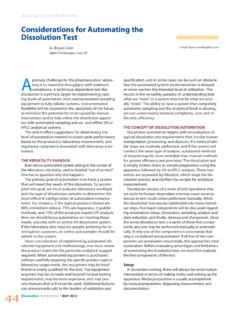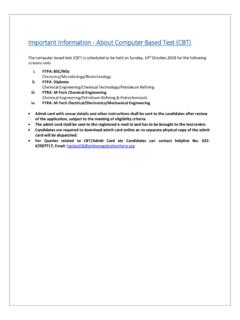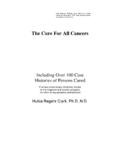Transcription of 4/3/2017 - sdshp.com
1 4/3/2017 . Sterile Compounding and Aseptic Technique: Reviewing the basics and preparing for USP <800>. Brenda Jensen CPhT, CNMT, MBA. SDSHP Annual Conference April 7-8, 2017. Disclosure The views and opinions expressed are those of the speaker and are not endorsed by or affiliated with USP. Conflict of Interest I have no financial relationships with any commercial sponsor with a vested interest in this presentation Technician Learning Objectives 1. review definitions related to compounding. 2. Explain proper hand-hygiene procedures and garbing order. 3. Discuss when to deactivate, decontaminate, clean and/or disinfect the PEC and C-PEC. 4. Locate the direct compounding area within the PEC. and C-PEC. 1. 4/3/2017 . Pharmacist Learning Objectives 1. review new acronyms introduced in USP <800>.
2 2. Explain appropriate clean room behavior. 3. Identify requirements for environmental monitoring. 4. Determine how to establish a BUD. United States Pharmacopeia (USP). USP <795> Nonsterile Compounding USP <797> Sterile Compounding USP <800> Nonsterile and Sterile Hazardous Drugs Related chapters <71>, <85>, <1163>, etc. Chapters numbered under 1000 are enforceable. Chapters numbered over 1000 are informational. Shall or Must Requirement Should - Recommendation CSP Compounded sterile preparation HD Hazardous Drug (as defined by NIOSH). BUD Beyond-use date Ante-Room ISO-7 or ISO-8 classified room where hand hygiene and garbing occur. 2. 4/3/2017 . PEC - Primary engineering control is where CSPs are compounded. Examples: LAFW and CAI. LAFW Laminar Airflow Workbench CAI Compounding Aseptic Isolator SEC Secondary engineering control is where PEC is located.
3 Examples: Positive pressure ISO-7 buffer room or segregated compounding area (SCA). C-PEC Containment primary engineering control is where hazardous CSPs are compounded. Examples: BSC and CACI. BSC Biological Safety Cabinet CACI - Compounding Aseptic Containment Isolator C-SEC - Containment secondary engineering control is where C-PEC is located. Examples: Negative pressure ISO-7 buffer room or containment segregated compounding area (C-SCA). Technician Learning Assessment An LAFW is an example of a C-PEC. True or False 3. 4/3/2017 . False An LAFW is an example of a PEC. Pharmacist Learning Assessment Compounding is performed in a C-SEC. located within a C-PEC. True or False False Compounding is performed in a C-PEC. located within a C-SEC. 4. 4/3/2017 . Hand-Hygiene and Garbing I. Ima Image from Why is it important?
4 Individuals shall not work in sterile compounding areas with Rashes Sunburn Weeping sores Conjunctivitis Active respiratory infection Before entering ante-room or segregated compounding area remove Outer garments Cosmetics Hand, wrist, visible jewelry and piercings ( , earrings, lip or eyebrow piercings). Nail polish Artificial nails Natural nails shall be kept neat and trimmed. 5. 4/3/2017 . Don garb dirtiest to cleanest Dedicated shoes or shoe covers on clean side of line of demarcation. Dirty shoes should never touch clean side. Head and facial hair covers ( , beard covers). Face masks Eye shields. Eye shields are optional unless working with irritants such as germicidal disinfecting agents or when preparing hazardous drugs. Perform hand hygiene Hand washing procedure shall be performed by removing debris from underneath fingernails using a nail cleaner under running warm water followed by vigorous hand washing.
5 Hands and forearms shall be washed to the elbows for at least 30 seconds with soap (either nonantimicrobial or antimicrobial). and water while in the ante-room. The use of antimicrobial scrub brushes is not recommended because they can cause skin irritation and skin damage. Hands and forearms to the elbows will be completely dried using either lint-free disposable towels or an electronic hand dryer. After completion of hand washing, a nonshedding gown with sleeves that fit snugly around the wrists and enclosed at the neck is donned. Gowns designated for buffer room use shall be worn, and preferably they should be disposable. If reusable gowns are worn, they should be laundered appropriately for buffer room use. Once inside the buffer room or segregated compounding area, and prior to donning sterile powder-free gloves, antiseptic hand cleansing shall be performed using a waterless alcohol-based surgical hand scrub with persistent activity.
6 Hands are allowed to dry thoroughly before donning sterile gloves. Sterile gloves shall be the last item donned before compounding begins. 6. 4/3/2017 . Disinfection of contaminated gloved hands may be accomplished by wiping or rubbing sterile 70% IPA to all contact surface areas of the gloves and letting the gloved hands dry thoroughly. Routine application of sterile 70% IPA to sterile gloves shall occur throughout the compounding process and whenever nonsterile surfaces ( vials, counter tops, chairs, carts) are touched. Properly garbed and gloved compounding personnel who are exposed to air quality that is either known or suspected to be worse than ISO Class 7 shall re-garb PPE. along with washing their hands properly, performing antiseptic hand cleansing with a waterless alcohol- based surgical hand scrub, and donning sterile gloves upon reentering the ISO Class 7 buffer room.
7 When compounding personnel exit the ante-room or segregated compounding area during a work shift, the exterior gown may be removed and retained in the ante-room or segregated compounding area if not visibly soiled, to be re-donned during that same work shift only. However, shoe covers, hair and facial hair covers, face masks/eye shields, and gloves shall be replaced with new ones before re-entering the ante-room or segregated compounding area, and proper hand hygiene shall be performed. 7. 4/3/2017 . Doff garb on the clean side of line of demarcation in ante-room or segregated compounding area. Remove gloves and perform hand hygiene. Remove gown and discard it, or hang it on hook if it is to be reused within the same work shift. Remove and discard mask, head cover, and beard cover. Remove shoe covers or shoes one at a time, ensuring that uncovered foot is placed on the dirty side of the line of demarcation and perform hand hygiene again.
8 (Remove and discard shoe covers every time the ante-room or segregated compounding area is exited). Additional PPE for Hazardous Compounding (per <800>). Don and doff within negative pressure buffer room or containment-segregated compounding area. HD PPE. must not be worn outside of negative pressure room. Second set of shoe covers. Chemo gown (may not be re-used). Change per manufacturer or every 2-3 hours or after splash/spill Two pairs of chemotherapy gloves. Change per manufacturer or every 30 minutes or after tear. Remove and discard outer glove while in BSC or CACI. Technician Learning Assessment Nails must be cleaned under running water before washing hands. True or False 8. 4/3/2017 . True Nails must be cleaned under running water before washing hands. Pharmacist Learning Assessment Pharmacists ____ need to garb to enter a segregated compounding area.
9 A. do b. do not a. do Pharmacists do need to garb to enter a segregated compounding area. 9. 4/3/2017 . Types of Primary Engineering Controls LAFW Laminar Airflow Workbench (PEC). Protects the product or preparation. No personnel protection. May be either horizontal or vertical air flow. BSC Biological Safety Cabinet (C-PEC). Protects personnel. Used for hazardous drugs. Vertical air flow. Class II Type A2, B1, or B2. Class III. Best to run PEC (LAFW) continuously. C-PEC (BSC) must run continuously (per <800>). LAFW/BSC must run 30. minutes before use after being off. Types of Primary Engineering Controls RABS Restricted Access Barrier System CAI Compounding Aseptic Isolator (PEC). Protects the product or preparation. No personnel protection. Vertical air flow, positive pressure. CACI Compounding Aseptic Containment Isolator (C-PEC).
10 Protects personnel. Used for hazardous drugs. Vertical air flow, negative pressure. Isolator Contains an internal system to decontaminate interior with sporicidal agent. Cleaning and Disinfection of PEC. At the beginning of each shift, before each batch, not longer than 30 minutes following the previous surface disinfection when ongoing compounding activities are occurring, after spills, and when surface contamination is known or suspected. Items shall be removed from areas to be cleaned, and surfaces shall be cleaned by removing loose material and residue from spills; , remove water-soluble residues with sterile water (for injection or irrigation). using low shedding wipes then wipe with a residue-free disinfecting agent such as sterile 70% IPA, which is allowed to dry before compounding begins.



